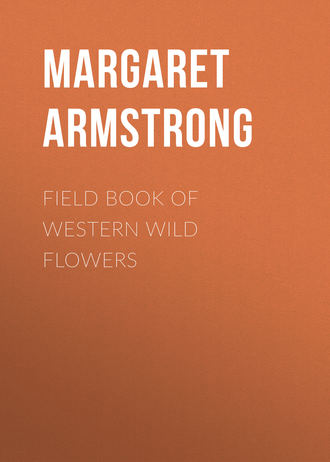 полная версия
полная версияField Book of Western Wild Flowers
The only kind, a fine plant, well worth cultivation; smooth and branching, about two feet tall, with handsome, bluish-green leaves, with a "bloom," the root-leaves with long, purplish leaf-stalks and sometimes nine inches long; the flowers half an inch across, with a lilac-tinged calyx and white petals, prettily toothed, forming a pretty, rather flat-topped cluster. The pods are very slender, nearly straight, one or two inches long. This grows among rocks, in protected situations, and is not common. Only a few, separate flowers are given in the picture, as the plant I found, near the Desert Laboratory at Tucson, was almost out of bloom.
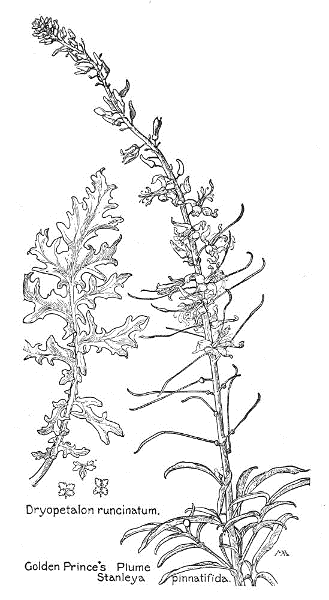
Dryopetalon runcinatum.
Golden Prince's Plume – Stanleya pinnatifida.
There are a good many kinds of Lesquerella, all American; low plants, more or less hairy or scurfy; flowers mostly yellow, in clusters; petals without claws; pods roundish, more or less inflated, and giving the common name, Bladder-pod, also used for Isomeris arborea.
White Bladder-pod
Lesquerélla purpùrea
White, pink
Spring Arizona
Pretty little plants, often growing in quantities among rocks in mountain canyons. The slender stems are from a few inches to over a foot tall, springing from a cluster of root-leaves, varying a good deal in shape, dull-green and harsh to the touch. The flowers are half an inch or more across, with white petals, often tinged with pink, with a little yellow in the throat, and form a pretty, rather flat-topped cluster.
Yellow Bladder-pod Lesquerélla Arizònica
Yellow
Summer
Arizona
In desert places, such as the terrible sandy wastes of the Petrified Forest, where it seems a miracle that anything should grow, we find the close, pale, gray-green tufts of this little plant, crowned with racemes of small bright-yellow flowers. The small, thickish leaves are long, narrow and white with close down, the stems, about three inches high, branch at the root and the little pods are tipped with a style of about their own length. L. Gordóni, of Arizona, also has clusters of little yellow flowers, often covering sandy hillsides with bright color; the leaves slightly stiff and rough, the pods much inflated. It resembles L. purpurea in general form and size.
There are many kinds of Brassica, coarse "weeds" in this country. This is the ancient Latin name for Cabbage, which belongs to this genus, as well as Cauliflower, Turnip, and Brussels Sprouts.
Black Mustard
Brássica nìgra
Yellow
Summer
U. S.
A European "weed," common everywhere. In California it grows to an enormous height, sometimes twelve feet, and when in bloom is a beautiful feature of the landscape, covering the fields with a shimmering sheet of pale gold. The leaves are dark-green, smooth or with a few hairs, all with leaf-stalks, the lower leaves large and jagged, cut into leaflets, the upper leaves mostly toothless. The fragrant flowers form long clusters, each flower about three-quarters of an inch across; the small, cylindrical pods stand erect, close to the branching stem. A valuable, antiseptic oil is made from the black, pungent seeds, exported from California by the ton.
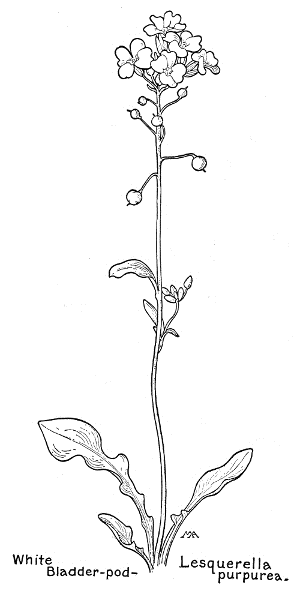
White Bladder-pod – Lesquerella purpurea.
CAPER FAMILY. Capparidaceae
The flowers of this family are much like the Mustards, but the stamens are all of equal length and are often more than six; the leaves are alternate and consist of three or several leaflets, with stalks, and the plant usually tastes bitter and disagreeable instead of pungent. There is no partition in the pods, which are on long, threadlike stalks; the ovary is superior and the seeds are kidney-shaped. Many flowers have only a rudimentary pistil and never produce fruit. The Caper, of which we eat the pickled flower-buds for a relish, is a shrub which grows in the Levant. The family is quite large and flourishes in warm regions.
There are several kinds of Cleomella, resembling Cleome, except that the pods are different.
Cleomella
Cleomélla lóngipes
Yellow
Spring
Nev., Cal., Oreg.
This is a handsome, rather odd-looking plant, with a stout, smooth, yellowish or purplish stem, sometimes branching and over a foot tall. The leaves are bright light-green, smooth, toothless and slightly thickish, and the three leaflets are sometimes each tipped with a hair, and have a tuft of small hairs at the base of the leaf-stalk, in place of a stipule. The flowers are about half an inch across, and are a beautiful warm shade of golden-yellow, the long stamens being of the same color and giving a very pretty feathery appearance to the large cluster. The pods are queer-looking little things and stick straight out from the stem. This has a slightly unpleasant smell, but looks very gay and pretty in the fields and along the edges of the mesas around Reno.

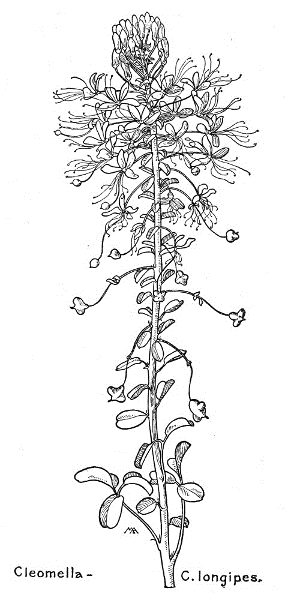
Cleomella – C. longipes.

There are many kinds of Cleome; ours are branching herbs, with palmately-divided leaves; the flowers with four sepals, four petals, and six stamens. The ovary has a stalk with a gland at its base and becomes a long pod, with a long stalk and many seeds.
Bee-plant
Cleòme serrulàta
Pinkish-lilac, white
Summer
Southwest, etc.
In Arizona this exceedingly handsome plant often covers the dry beds of rivers with acres of beautiful color. The smooth, branching stem is sometimes as much as eight feet high. The upper leaves are long and narrow and the lower are larger and usually have three leaflets, but all are bluish-green and peculiarly soft and smooth to the touch. The buds are purple and the delicate flowers, with threadlike flower-stalks, grow in a handsome, feathery cluster, sometimes a foot long, with numerous bracts. They have four, pinkish-lilac or white petals and six exceedingly long, threadlike stamens with minute, curling, green anthers. The lilac pistil is also very long and before the flower drops off begins to develop into a small, flat, green pod. These gradually lengthen, until the stem is ornamented with many hooklike pods, with slender stalks, hanging all along it. Many of the flowers do not produce fruit. The foliage when it is crushed gives off a rank, unpleasant smell, which is responsible for the local name of Skunk-weed. This is widely distributed and is found in the central and northern part of the United States, as well as in the Southwest.

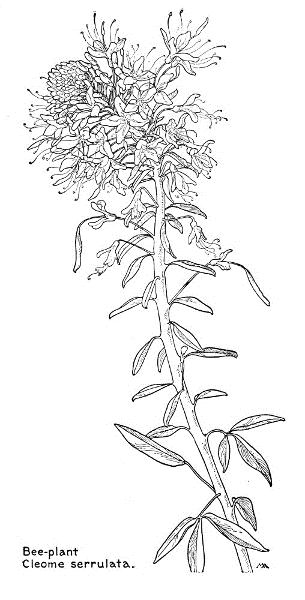
Bee-plant – Cleome serrulata.

Yellow Cleome
Cleòme platycàrpa
Yellow
Spring
Nevada
An odd-looking plant, with very pretty, feathery flower-clusters. The hairy stem is over a foot tall and the leaves are bright yellowish-green and mostly smooth on the upper side, with hairy margins and hairy on the under side. The flowers are a warm shade of bright golden-yellow and form a handsome, rather flat-topped cluster, with long stamens, and the oblong pods are an inch long or less, flat and much broader than those of the last. The flowers are slightly sweet-scented and the whole plant exudes a faint unpleasant odor. This is conspicuous on the dreary mesas around Reno, often growing with Cleomella longipes, which it very much resembles in general appearance, except for the pods, which are quite different.
There is only one kind of Isomeris.
Bladderpod
Isómeris arbòrea
Yellow
Spring
California
This is a shrub about three feet high, which is attractive except for its unpleasant smell. The leaves are smooth, toothless, stiffish and thickish, and bluish-green, with a small bristle at the tip, and mostly with three leaflets. The pretty flowers are nearly an inch across and warm yellow in color, not very bright but pretty in tone, with six very long, yellow stamens, and form a short, oblong cluster. The ovary has such a long stalk, even in the flower, that it gives an odd appearance and it develops into a very curious and conspicuous, drooping pod, an inch and a half long, much inflated and resembling a very fat pea-pod, on a long stalk, with two rows of seeds like little peas inside it, which taste very bitter. This is quite common on southern mesas. The name Bladderpod is also used for Lesquerella, which belongs to the Mustard Family.

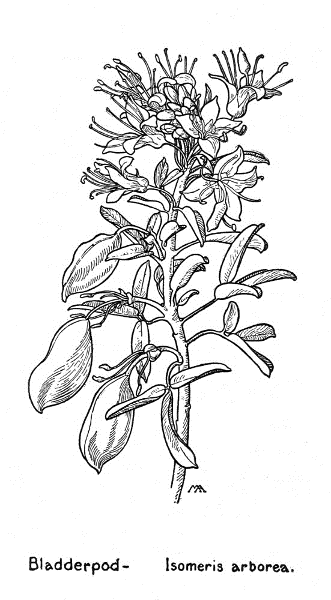
Bladderpod – Isomeris arborea.
ORPINE FAMILY. Crassulaceae
A rather large family, widely distributed; odd-looking, mostly very succulent herbs, with smooth, fleshy leaves and stems, without stipules; flowers in clusters; sepals, petals, pistils, and stamens, all of the same number, usually four or five, sometimes the stamens twice as many; ovary superior; receptacle with honey-bearing scales, one behind each pistil; pistils separate, developing into small dry pods, containing few or many, minute seeds. Some of these plants look like tiny cabbages and we are all familiar with their tight little rosettes in the formal garden-beds of hotels and railway stations, where they are so stiff and unattractive that we hardly recognize them when we find them looking exceedingly pretty in their natural homes. The Latin name means "thick."
There are many kinds of Sedum, no one kind very widely distributed; fleshy herbs; leaves usually alternate; flowers star-like, often in one-sided clusters; stamens and pistils sometimes in different flowers on different plants; sepals and petals four or five; stamens eight or ten, on the calyx, the alternate ones usually attached to the petals; styles usually short. The Latin name means "to sit," because these plants squat on the ground, and Stonecrop is from their fondness for rocks.
Douglas Stonecrop
Sèdum Douglásii
Yellow
Spring, summer
Northwest
This makes beautiful golden patches, on dry slopes or more or less open hilltops, usually among limestone rocks. The reddish stems are from six to ten inches tall, the leaves are rather long and narrow, thick but flat, forming pretty pale-green rosettes, more or less tinged with pink and yellow, and the pretty starry flowers are three-quarters of an inch across, bright-yellow, with greenish centers, the stamens giving a feathery appearance.
Yosemite Stonecrop
Sèdum Yosemiténse
Yellow
Summer
California
On moss-covered rocks, moistened by the glistening spray blowing from the Yosemite waterfalls, we find these beautiful plants, covering the stones with a brilliant, many-colored carpet. The flowers are stars of brightest gold, about half an inch across and delicately scented, and form flat-topped clusters, three or four inches across. The upper part of the stalk, which is about six inches tall, and the upper leaves are delicate bluish-green, but both stem and leaves shade to vivid scarlet at the base. Spreading out on the ground from the base of the stem in all directions are numerous little runners, each bearing at the end a small rosette of thick, blue-green leaves, forming a beautiful contrast to the vivid color of flowers and stems. The leaves and runners are very brittle and break off at a touch.
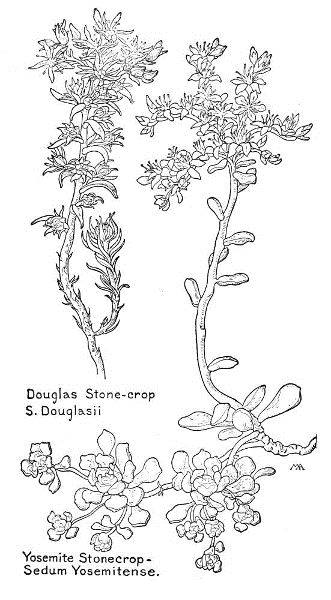
Douglas Stone-crop – S. Douglasii.
Yosemite Stonecrop – Sedum Yosemitense.
There are several kinds of Dudleya; perennials, very thick and fleshy; root-leaves in a conspicuous rosette, stem-leaves mostly bract-like, usually with a broad, clasping base; flowers mostly yellow or reddish; calyx conspicuous, with five lobes; petals united at base; stamens ten. Most of these plants grow in the South, often on rocks, in such shallow soil, that they would die in dry weather, except that the juicy leaves retain their moisture for a long time and nourish the plant. They resemble Sedum in appearance, but as the petals are more or less united the flowers are not starlike. The Indians make poultices out of the leaves.
Hen-and-Chickens
Dúdleya Nevadénsis (Cotyledon)
Orange-red
Summer
California
The succulent, reddish flower-stalks of this handsome plant bear large, loose, rather flat-topped clusters of orange-red flowers, on coiling branches, and are about a foot tall, with scaly bracts, springing from a large handsome rosette on the ground of very thick, pale-green leaves, often tinged with pink. Other smaller rosettes form a circle around it, hence its nice little common name. D. pulverulénta (Echeveria) is beautiful but weird-looking. It has red flowers, and the rosette, resembling a small Century-plant, is covered all over with a white powder which, among ordinary herbage, gives an exceedingly striking and ghostlike effect. This plant is sometimes a foot and a half across, with as many as eight, tall stalks, and is found from San Diego to Santa Barbara.
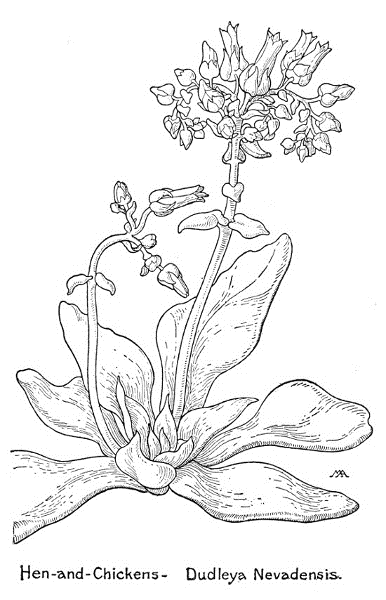
Hen-and-Chickens – Dudleya Nevadensis.
SAXIFRAGE FAMILY. Saxifragaceae
A large family, almost all herbs, living usually in temperate regions. They have no very peculiar characteristics and resemble the Rose Family, but sometimes their leaves are opposite, usually they have no stipules and have fewer stamens than Roses, not more than twice as many as the sepals, and usually the pistils, from two to five in number, with distinct styles, are united to form a compound ovary, which is superior or partly inferior; sepals usually five; petals four, five, or rarely none, alternate with the sepals; petals and stamens borne on the calyx; fruit a dry pod or berry, containing numerous seeds. The Latin name means "rock breaker," as many grow among rocks.
There are several kinds of Parnassia, of north temperate and arctic regions; smooth perennials; leaves toothless, almost all from the root; flowers single; sepals five; petals five, each with a cluster of sterile filaments, tipped with glands, at the base; fertile stamens five, alternate with the petals; ovary superior, or partly inferior, with a very short style, or none, usually with four stigmas; fruit a capsule, containing numerous winged seeds. These plants were called Grass of Parnassus by Dioscorides, but are not grasslike. They resemble the other members of this family so little that they have been made into a separate family by some botanists.
Grass of Parnassus
Parnássia fimbriàta
White
Summer
Northwest
A charming plant, with several slender stems, about a foot tall, springing from a large cluster of handsome, very smooth, glossy leaves. The flowers are about an inch across and have cream-white petals, delicately veined with green and prettily fringed towards the base, and pale yellow anthers. At the base of each petal there is a queer little stiff cluster of sterile filaments, like a tiny green hand. This grows on banks of streams and in moist places, reaching an altitude of eleven thousand feet. P. Californica is similar, but the petals not fringed.
There are several kinds of Leptasea, perennials, with alternate, thick or stiffish leaves; flowers white or yellow, single or in terminal clusters; sepals five; petals five, with claws or claw-like bases; stamens ten; ovary mostly superior.
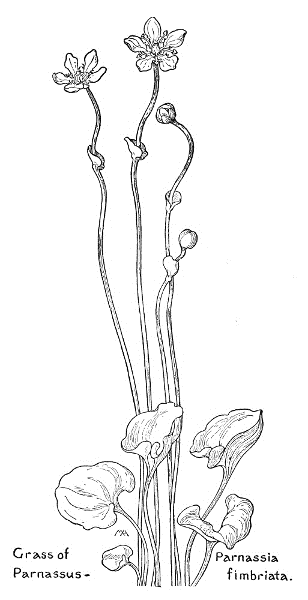
Grass of Parnassus – Parnassia fimbriata.
Dotted Saxifrage
Leptàsea austromontàna. (Saxifraga bronchialis)
White
Summer
Northwest
Pretty little plants, about six inches tall, forming matted clumps of stiff, rather dark green foliage, the twigs crowded with leathery, toothless leaves, bristly along the edges and tipped with a little stiff point. The pretty flowers are about half an inch across, their white petals dotted with dark red or purple towards the tips, sometimes dotted with yellow near the center, with yellow anthers and a pale green ovary, partly inferior. These little plants sometimes cover rocky slopes for long distances with their leafy mats and are common in the mountains at moderate altitudes.
There are several kinds of Muscaria, perennial, matted herbs; leaves alternate, usually three-lobed, mostly from the root; flowers white, single, or a few in terminal clusters; sepals five; petals five, without claws; stamens ten; ovary about one-half inferior.
Tufted Saxifrage
Muscària caespitòsa (Saxifraga)
White
Summer
Northwest, etc.
Pretty little plants, from two to six inches tall, with small leaves, with from three to five lobes or teeth, forming matted patches of pretty foliage, from which spring many slender, slightly hairy flower-stems, with a few bracts or leaves, and bearing one or more pretty flowers, less than half an inch across, with white petals, yellow anthers, and a greenish-yellow ovary. This grows in rocky crevices in the mountains, across the continent, also in arctic and alpine Europe and Siberia.
There are a good many kinds of Lithophragma, perennials, bearing bulblets on their slender rootstocks and sometimes also on the stems; leaves more or less divided, mostly from the root; stipules small; flowers few, in a loose, terminal cluster; sepals five; petals five, white or pink, with claws; stamens ten, short; ovary superior or partly inferior, with three short styles.
Woodland Star
Lithophrágma heterophýlla
White
Spring, summer
California
A little woodland plant, delicate and pretty, with a slender, hairy stem, from nine inches to two feet tall, springing from a pretty cluster of hairy leaves, variable in shape, but usually with three or five lobes. The starry flowers are three-quarters of an inch across, with white petals, prettily slashed. This is sometimes called Star of Bethlehem, but that name belongs to an Ornithogalum, grown in gardens.
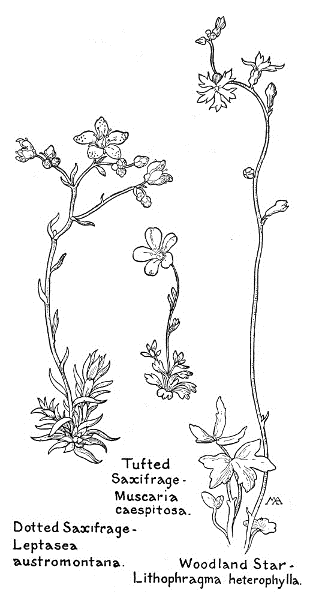
Dotted Saxifrage – Leptasea austromontana.
Tufted Saxifrage – Muscaria caespitosa.
Woodland Star – Lithophragma heterophylla.
Youth-on-age
Leptáxis Menzièsii.(Tolmiea)
Purplish
Summer
Wash., Oreg., Cal.
The only kind, a perennial, over a foot tall, with a hairy stem bearing a graceful wand of small flowers, springing from a cluster of root-leaves, bright green and thin in texture, but roughish and sparsely hairy. The flowers are about a third of an inch long, the calyx, which is the conspicuous part, dark-purple or pinkish-red and slightly irregular, with three large and two small sepals, and the petals of the same color, but so narrow that they look like long curling filaments. The three stamens are opposite the three upper sepals, the ovary is superior and the capsule has two long beaks. Young plants often spring from the base of the leaf, where it joins the leaf-stalk, and this habit gives the common name. This grows in mountain woods and is attractive, for though the flowers are dull in color they are unusual in form and the leaves are pretty.
There are a good many kinds of Heuchera, North American, difficult to distinguish; perennials, with stout rootstocks; leaves mostly from the root; flowers small, in clusters; calyx-tube bell-shaped, with five lobes; petals small, sometimes lacking, on the throat of the calyx, with claws; stamens five, inserted with the petals; ovary partly inferior, with two slender styles, becoming two beaks on the capsule.
Alumroot
Heuchèra micrántha
Pink and white
Summer
Cal., Oreg., Wash.
These feathery sprays are so airy and delicate that they might almost be made of mingled mist and moonshine, blown from the waterfalls they love to haunt, but are not so fragile as they look, for the clusters of tiny pink and white flowers last a long time in water. The stem is very slender, rather hairy, from one to three feet tall, springing from a cluster of roundish leaves, prettily lobed and scalloped, bright green, with some white hairs on the backs and on the long leaf-stems, often with red veins. The handsome leaves and lovely feathery spires are conspicuous, decorative and quite common, among mossy rocks in dark, rich mountain woods, up to six thousand feet.
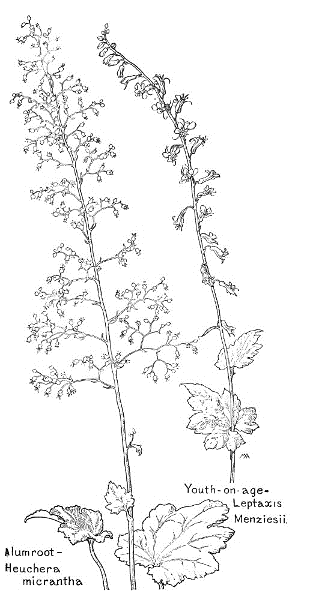
Alumroot – Heuchera micrantha.
Youth-on-age – Leptaxis Menziesii.
Alumroot
Heuchèra rubéscens
Pink and white
Summer
Southwest, Utah, Nev.
This is not so tall and the leaves, with blunt teeth and sometimes slightly lobed, are smaller. In Utah they are dark green and shining on the upper side, smooth or slightly downy, with a bristle at the tip of each lobe, often reddish on the under side, and in Yosemite quite rough, with hairs on the edges and veins. The flowers are about a quarter of an inch across, the calyx deep-pink, with blunt, green teeth, the petals long, narrow and white, the general effect of the flower being pink. The clusters are not nearly so airy as those of H. micrantha and in the high Sierras the stems are shorter and the clusters still more compact. This was first found on one of the islands in Great Salt Lake. There are other similar kinds, some with greenish flowers.
There are several kinds of Micranthes, perennials, sometimes with bulblets at the base of the stem; leaves thickish, from the root; flowers white, in terminal clusters; petals five, mostly without claws; stamens ten; ovary slightly inferior.
Tall Swamp Saxifrage
Micránthes Oregàna (Saxifraga)
White
Summer
Northwest
This is conspicuous on account of its height, with a stout, stiff, leafless, hairy flower-stalk, three feet or more tall, springing from a loose rosette of smooth, thickish, bright-green leaves, not standing up stiffly but spreading, sometimes nearly a foot long, paler on the under side and obscurely toothed at the ends, with some minute hairs along the lower margins. The flowers are small, with cream-white petals, orange-red anthers and a green ovary, and form a long branching cluster towards the top of the stalk. This grows in swamps in the mountains.

